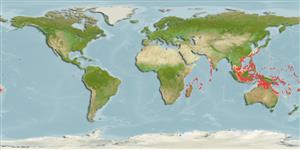Common names from other countries
>
Perciformes/Serranoidei (Groupers) >
Anthiadidae (Fairy basslets or Streamer basses)
Etymology: Plectranthias: Greek, plektron = anyhting to strike with, spur + Greek, anthias = a fish, Sparus aurata (Ref. 45335).
More on author: Weber.
Environment: milieu / climate zone / depth range / distribution range
Ecología
marino asociado a arrecife; rango de profundidad 6 - 75 m (Ref. 48635). Tropical; 36°N - 31°S, 30°E - 174°W
Indo-West Pacific: East Africa to Fiji, north to southern Japan, south to Queensland. Recently recorded from Tonga (Ref. 53797).
Length at first maturity / Tamaño / Peso / Age
Maturity: Lm ?, range 2 - ? cm
Max length : 3.5 cm SL macho / no sexado; (Ref. 48635)
Espinas dorsales (total) : 10; Radios blandos dorsales (total) : 13 - 14; Espinas anales: 3; Radios blandos anales: 6 - 7. GR with additional 3-6 rudiments.
A cryptic (Ref. 2334), shallow-water species collected with the use of ichthyocides (Ref. 26833). Secretive amongst small boulders or bommies on coastal sand slopes with rich invertebrate and algae growth (Ref. 48635). Solitary in crevices (Ref 90102).
Life cycle and mating behavior
Maturities | Reproducción | Spawnings | Egg(s) | Fecundities | Larva
Randall, J.E., G.R. Allen and R.C. Steene, 1990. Fishes of the Great Barrier Reef and Coral Sea. University of Hawaii Press, Honolulu, Hawaii. 506 p. (Ref. 2334)
IUCN Red List Status (Ref. 130435)
CITES (Ref. 128078)
Not Evaluated
Threat to humans
Harmless
Human uses
Pesquerías: sin interés
Herramientas
Special reports
Download XML
Fuentes de Internet
Estimates based on models
Preferred temperature (Ref.
115969): 24.7 - 28.8, mean 27.6 (based on 452 cells).
Phylogenetic diversity index (Ref.
82804): PD
50 = 0.5000 [Uniqueness, from 0.5 = low to 2.0 = high].
Nivel trófico (Ref.
69278): 3.5 ±0.50 se; based on food items.
Resiliencia (Ref.
120179): Alto, población duplicada en un tiempo mínimo inferior a 15 meses (Preliminary K or Fecundity.).
Fishing Vulnerability (Ref.
59153): Low vulnerability (10 of 100).
